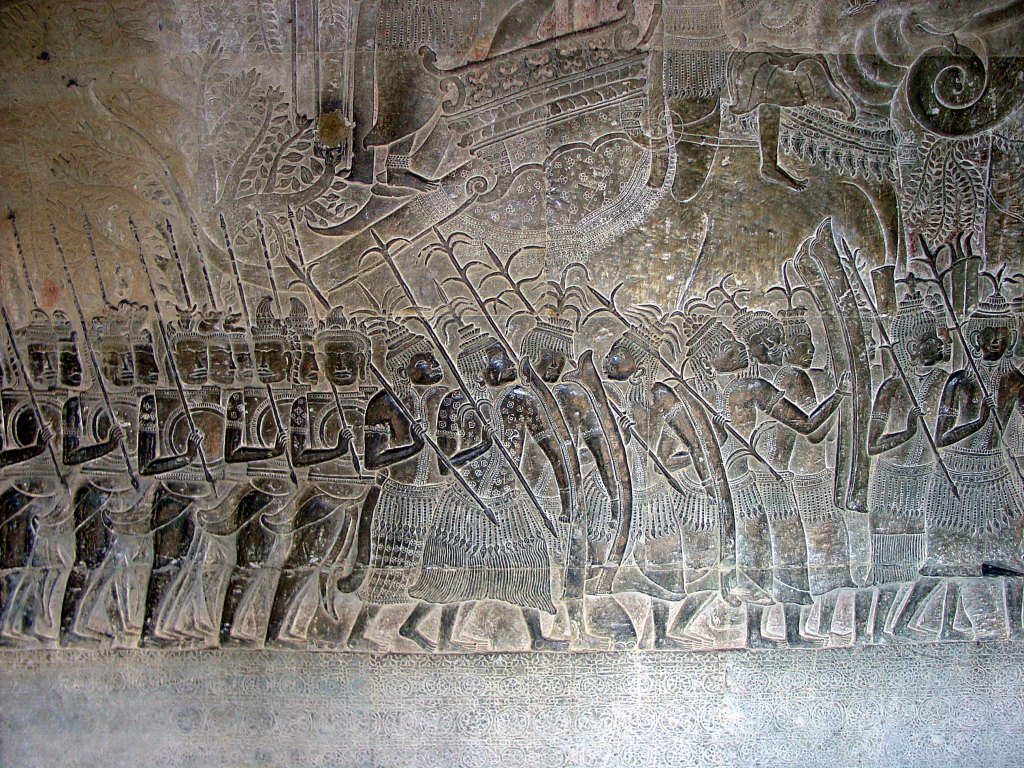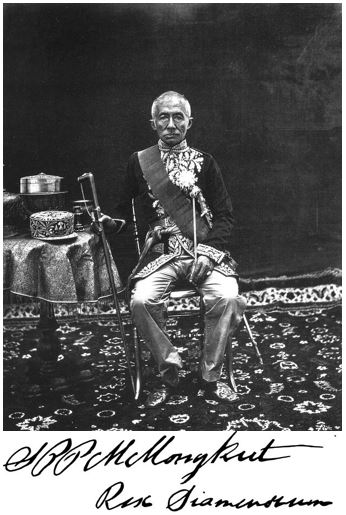On 11th May 1949 Radio Bangkok announced to the world that from that day on Siam would be known as Thailand. And so it has been for the last seventy years now. But in fact it was the second time within ten years this name change had occurred and the change was not particularly popular. So what was it that prompted the change and why the swapping back and forth?
Why Siam ?
The story must begin with the name Siam and where this originated from. And therein lies a mystery in that nobody is quite sure why Thailand was ever called Siam in the first place. The Thais themselves always referred to their country as “Meuang Thai”. But to outsiders the country had long been known as Siam.
The name Siam first appears in Cham inscriptions of the eleventh century writing about prisoners of war (The Chams were a race of seafaring people who settled in what is now southern Vietnam, establishing Champa which reached its zenith in the twelfth century). In the twelfth century the great southern gallery bas-relief of Angkor Wat was carved depicting a huge military procession led by the Khmer ruler Suryavarman II. At the front of the procession are warriors armed with spears dressed quite differently to the Khmers and identified in two inscriptions as “Siamese”.

Chinese records tell of a diplomatic embassy to the region in 1282 in which Sukhothai is referred to as “Sien”. There is some speculation that the word Siam is derived from the Sanskrit word “syama” meaning dark, a reference to the dark skin colour of the Thais. Whatever the origin, the word Siam seems to have been in common usage prior to the first arrival of Europeans in 1511. By the nineteenth century King Mongkut (Rama IV) would sign as “Rex Siamensium” in his frequent correspondence with foreigners.

Mutual Misunderstandings
The Thais always referred to their territory as “Meuang Thai” but “meuang” has never had the meaning of “nation”. Rather it denotes a city and the wider surrounding area under its control. The precise boundary between one meuang and another would be ill-defined and not considered of importance and people living in the peripheral zones may be beholden to the rulers of more than one meuang.
When Europeans arrived in Bangkok in the nineteenth century they bought with them a foreign concept of “Nation”. For the Europeans a “Nation” needed to be defined by precise borders drawn on maps. Furthermore a “Nation” would correspond to a particular race or ethnicity usually denoted by language. These differing concepts of territorial control caused ongoing misunderstandings in the early years of contact and negotiations. Early requests by the British to jointly survey and map the borders were met initially with indifference by the Thais and later by confusion when the British demanded to see non-existent treaties that might define the borders.
By the end of the nineteenth century however, King Chulalongkorn’s administration had absorbed the new concepts of a “Nation” and driven by urgent necessity actively participated in border surveys and negotiations defining its boundaries with British and French colonies. The first map of Siam’s borders was published in 1894 shortly after the Paknam Crisis had nearly resulted in the colonization of Siam by France (Read more on this crisis here).

In 1900 the Siamese school book “Geography of Siam” by W.G.Johnson was published which for the first time introduced the word “Prathet” to mean “Nation”. The traditional concept of Mueang Thai had been replaced by Prathet Siam.
Why Thailand ?
By the late 1930’s Siam had changed enormously. The absolute monarchy had been overthrown in 1932 by “The People’s Party”, a grouping of military and civilian non-royal elite and intellectuals. In 1938 Field Marshal Plaek Phibun Songkhram rose up from the military faction to become Prime Minister. With the world on the brink of global conflict, nationalism was a driving philosophy of the age and one fully embraced by Prime Minister Phibun. It was his belief that only large, strong nations would survive the coming struggle whilst smaller nations would be subsumed. He therefore strongly encouraged the idea that Siam had until recently been a much larger nation before territory was lost to the French in Laos and Cambodia and to the British in Burma and Malaya. His key minister Luang Wichit Wathakan took this idea further, using a French map to explain that up to 60 million Thai people inhabited a region from southern China, through Burma and Assam, across Siam to Laos and Cambodia. The vision of a “Greater Thai Kingdom” was created and Wichit proposed that the first step in achieving this pan-Thai vision would be to rename Siam to Thailand (Prathet Thai) to better reflect the racial make up of the nation.

But nationalism of a different kind within Siam also played a key part in the push to change the name. Since 1880 there had been considerable immigration of Chinese into Siam and in the 1920’s another surge in immigration added a further half-a-million Chinese to the population. More urbanized than the majority of the Thai population they came to dominate the urban trading scene and particularly the vital rice milling industry. But China was going through a social revolution at this time, culminating in the Xinhai Revolution of 1911 that overthrew the Qing dynasty and replaced it with a nationalist government. Furthermore in the 1930’s the second Sino-Japanese War stirred up Chinese nationalist sentiment. The Siamese government became increasingly concerned with the nationalist politics within the large Chinese community which sometimes broke out into violence, the potential stranglehold the community could have on Siam’s economy as demonstrated by boycotts called against Japanese goods, as well as the large outflow of money from Siam to support Chinese in the “homeland”.

Chinese economic power was the cause of much concern for the government of Phibun Songkhram
By the late 1930’s Phibun Songkhram’s government was restricting Chinese schools, shutting down banks that were sending money to China, suppressing Chinese newspapers and nationalizing the rice milling industry. Thus a significant factor behind the decision to change the country’s name to Thailand was in emphasizing that this was a land for Thai people over Chinese immigrants.
Cultural Mandate Number 1
On June 24th 1939 Phibun Songkhram’s government marked the seventh anniversary of the 1932 revolution that overthrew the absolute monarchy by announcing the first of what would eventually be twelve “Cultural Mandates”. These were a series of state edicts to the population released over a three year period. Phibun and his minister Wichit intended that these mandates would address the “flaws” which hampered the country’s progress. The very first mandate read ;
1. The country is to be called ‘Thailand’
2. The people and nationality are to be called ‘Thai’

The decision to change the name of the country had been made in a cabinet meeting on 8th May, being discussed for a mere ten minutes by the six ministers present. The proposal was opposed by half the cabinet members present but nevertheless was pushed through by Phibun and Wichit against the objections. By decreeing the country’s change of name via a “Cultural Mandate” Phibun Songkhram side stepped a potentially lengthy debate in the National Assembly, where no doubt there would have been considerable opposition. It was in fact only in August 1939 that legislation was passed to formally legalize what had been previously announced in Cultural Mandate No. 1.
Just over a month after this first edict, Cultural Mandate No. 3 was issued which decreed ” Use the name ‘Thai’ to refer to all Thai people, without sub-dividing them”. The policy was to reinforce the idea of a Thai nation for a single Thai race. This was emphasized further by Mandate No. 9 one year later which stated “Thai people must not consider place of birth, residence, or regional accent as a marker of division. Everyone must hold it to be true that all born as Thai people have the same Thai blood and speak the same Thai language. Place of birth or accent makes no difference”. Old distinctions between Thai, Chinese, Lao, Northern-Thai, Southern-Thai were all to be subsumed under one concept of the Thai citizen.
From Thailand to Siam and Back
As the Second World War progressed the fortunes of Field Marshal Phibun Songkhram and Luang Wichit Watakhan followed the trajectory of Japan’s fortunes. Their nationalist agenda and regional ambitions peaked in about 1942 but then began inevitably to decline. In July 1944 Phibun’s government collapsed and he was forced from power. As the war ended the new civilian led government announced on 7th September 1945 that the English name of the country would be restored to Siam. At this time Thailand was going through difficult negotiations with the British who considered Thailand to be an enemy power. The name change was intended to distance the new government from its nationalist predecessor.

Conditions in post-war Siam were very difficult with shortages of all commodities. The post-war government struggled to maintain support and in November 1947 the military staged another coup d’état. Five months later Phibun Songkhram performed one of the most remarkable political come-backs of all time, returning to the post of Prime Minister. In his second premiership Phibun promoted himself as a defender of democracy, gaining support from the US in the emerging Cold War. However he again initiated anti-Chinese campaigns and pursued an economic policy of nationalization of key industries. In line with these policies the name of Siam was once again changed to Thailand on 11th May 1949.
After seventy years one would think that the debate about the name of Thailand would finally be settled. In fact in 1968 the issue was discussed again in relation to the drafting of a new constitution. Even more recently in 2007 Thai historian Charnvit Kasetsiri started a petition to restore the name Siam, stating “If we want our country to be more inclusive, the name Siam is more appropriate”. It appears that the petition flopped but one never knows, perhaps one day the name Siam may again grace the world’s maps.
References
- The Indianized States of Southeast Asia, George Cœdès. Reprinted 1975, ANU Press.
- Siam Mapped, Thongchai Winichakul. Silkworm Books, 1994.
- Luang Wichit Wathakan and the Creation of Thai Identity, Scot Barmé. Institute of SE Asian Studies, 1993.
- National Identity and Its Defenders, Chapter 3, Chai-Anan Samudavanija. Silkworm Books, 1991.
- Surveying and Exploring in Siam, James McCarthy. Reprinted 1994 White Lotus Press
- https://www.thestar.com.my/opinion/columnists/thaitakes/2007/04/14/historian-campaigns-to-rename-thailand-siam/#sETtBoxo7OcuMhVy.99
Header Image – 5 Baht stamp from the King Bhumipol Rama IX 1st series, first issued 15/11/1947

I read somewhere that Siam was a Portuguese mistranslation of the Chinese term for the region, Xian. Not particularly helpful as I can’t remember where I read it but it seems plausible.
LikeLike
Hi Daniel, yes I’ve read similar explanations myself. But it seems to me that it is unlikely that the Chinese were themselves the originator of the word “Xian” or “Sian”. I think more likely the term originated from the local Indic influenced Chams or Khmers who applied the Sanskrit word Syam to the new Tai groups who were moving down from southern China. The Chinese on their journeys to the regions then picked up the term and copied as best they could in Chinese and much later the Portuguese did similar. I must check up how the Persians referred to the Siamese. The Persians were already entrenched in Ayutthaya when the Portuguese arrived.
Thanks for your interest !
LikeLike
I would also add that the concept of a “nation” was relatively new to the Europeans themselves. The modern concept of the nation state was born from the American and French revolutions although the etymology of the word dates back to Imperial Rome.
LikeLike